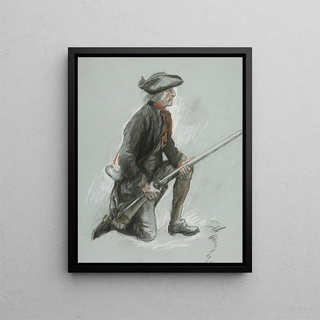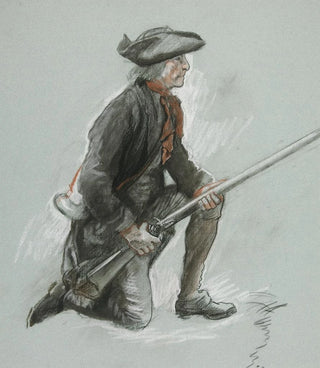Art print | Study for a figure of the mural fresco of Valley Forge at the Capitol of the State in Harrisburg, Pennsylvania. - Edwin Austin Abbey


View from behind

Frame (optional)
Valley Forge Wall Mural Study for the Capitol of the State in Harrisburg, Pennsylvania - Edwin Austin Abbey – Captivating introduction
In the vibrant universe of American art, Edwin Austin Abbey's work stands out for its ability to capture the essence of a historic moment while revealing the emotional depth that accompanies it. The art print of the study for a figure of the Valley Forge wall mural, located at the State Capitol in Harrisburg, Pennsylvania, invites the viewer to immerse themselves in a rich and evocative visual narrative. This piece, both monumental and intimate, evokes the struggle and sacrifice of American soldiers during the Revolution, while highlighting the power of art as a vehicle of collective memory.
Style and uniqueness of the work
Abbey's study is characterized by impressive technical mastery, blending realism and romanticism. The human figures, meticulously detailed, seem to come alive under the artist's skillful brushstrokes. The choice of colors, both vivid and nuanced, creates a dramatic atmosphere that transports the viewer to the heart of the action. Abbey manages to establish a subtle balance between movement and serenity, paying homage to the bravery of the heroes while emphasizing the gravity of their fight. Every element of the composition is carefully thought out, from the postures of the characters to the lighting that highlights their expressions. This attention to detail gives the work narrative depth, allowing the audience to engage with the story on an emotional and intellectual level.
The artist and his influence
Edwin Austin Abbey, born in 1852 in Philadelphia, is an iconic figure of the American artistic movement at the end of the 19th century and the beginning of the 20th century. His career, marked by an exploration of historical and literary themes, reflects a passion for visual storytelling. Influenced by the Pre-Raphaelites and the Arts and Crafts movement, Abbey was able to incorporate elements of romanticism and symbolism into his works. His commitment to American history, notably through monumental frescoes, left an indelible mark on the artistic landscape of his time. Abbey does not merely depict past events;

Matte finish

View from behind

Frame (optional)
Valley Forge Wall Mural Study for the Capitol of the State in Harrisburg, Pennsylvania - Edwin Austin Abbey – Captivating introduction
In the vibrant universe of American art, Edwin Austin Abbey's work stands out for its ability to capture the essence of a historic moment while revealing the emotional depth that accompanies it. The art print of the study for a figure of the Valley Forge wall mural, located at the State Capitol in Harrisburg, Pennsylvania, invites the viewer to immerse themselves in a rich and evocative visual narrative. This piece, both monumental and intimate, evokes the struggle and sacrifice of American soldiers during the Revolution, while highlighting the power of art as a vehicle of collective memory.
Style and uniqueness of the work
Abbey's study is characterized by impressive technical mastery, blending realism and romanticism. The human figures, meticulously detailed, seem to come alive under the artist's skillful brushstrokes. The choice of colors, both vivid and nuanced, creates a dramatic atmosphere that transports the viewer to the heart of the action. Abbey manages to establish a subtle balance between movement and serenity, paying homage to the bravery of the heroes while emphasizing the gravity of their fight. Every element of the composition is carefully thought out, from the postures of the characters to the lighting that highlights their expressions. This attention to detail gives the work narrative depth, allowing the audience to engage with the story on an emotional and intellectual level.
The artist and his influence
Edwin Austin Abbey, born in 1852 in Philadelphia, is an iconic figure of the American artistic movement at the end of the 19th century and the beginning of the 20th century. His career, marked by an exploration of historical and literary themes, reflects a passion for visual storytelling. Influenced by the Pre-Raphaelites and the Arts and Crafts movement, Abbey was able to incorporate elements of romanticism and symbolism into his works. His commitment to American history, notably through monumental frescoes, left an indelible mark on the artistic landscape of his time. Abbey does not merely depict past events;






